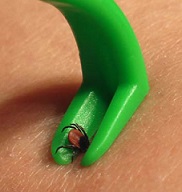How to Prepare for Tick Season
Governor Bob McDonnel proclaimed May as Lyme Disease Awareness Month in Virginia. This year he signed the Lyme Disease Testing Information Disclosure Act of 2013 into legislation. This made Virginia the first state that requires “health care providers to notify anyone tested for Lyme disease that current laboratory testing can produce false negatives, especially in the early stages of the disease”. The governor’s home was lit up in lime green in congjunction with the new legislature, and the National Capital Lyme Disease Assocation provided green bows to state senators and delegates that supported the bill.
 The original article can be found here: http://www.nvdaily.com/news/2013/05/governor-sheds-light-on-lyme-disease-awareness.php
The original article can be found here: http://www.nvdaily.com/news/2013/05/governor-sheds-light-on-lyme-disease-awareness.php
Even though June is now upon us, Lyme Disease will continue to be a persistent threat throughout the summer, as ticks are most active during this time of year. Lyme Disease, however, is not the only pathogen that ticks can transmit. In fact, they can transmit various bacterial or viral infections, including: Relapsing Fever, Typhus, Rocky Mountain Spotted Fever, Ehrlichiosis Anaplasmosis, Tularemia, Colorado Tick Fever, Babesiosi, Cyatauxzoonosis, and Tick Paralysis. Also, ticks can transmit more than one pathogen at a time, which can make diagnosis and treatment very difficult. Symptoms generally present themselves about 4 hours after being bitten by the tick, and can occur up to 6 months after having a tick bite. Lyme Disease in specific can take 3 to 30 days before the typical “bulls-eye” rash appears, though it takes 36 hours for the tick to attach itself and transmit the disease. While most people will have a rash, others might have a fever without a rash. Commonly experienced symptoms for all of the above illnesses include body aches, fever, fatigue, joint paint, and rashes.
 The best way to avoid illnesses spread by ticks, is to avoid getting bitten in the first place. Pathogens inside the ovaries of a female tick can cause larva to be infectious immediately upon hatching, so it’s always important to be prepared when in a tick-prone area. The easiest way to do this is to limit exposure to wooded areas. Tick reppelant should always be used, on both exposed skin and clothing. Shirts should be tucked into pants, and pant legs into socks, and clothing should be washed immediately if exposure occurs. Always be sure to inspect for signs of ticks after spending time outside, including on any pets that were outside as well.
The best way to avoid illnesses spread by ticks, is to avoid getting bitten in the first place. Pathogens inside the ovaries of a female tick can cause larva to be infectious immediately upon hatching, so it’s always important to be prepared when in a tick-prone area. The easiest way to do this is to limit exposure to wooded areas. Tick reppelant should always be used, on both exposed skin and clothing. Shirts should be tucked into pants, and pant legs into socks, and clothing should be washed immediately if exposure occurs. Always be sure to inspect for signs of ticks after spending time outside, including on any pets that were outside as well.
If a tick is found, fine-tipped tweezers can be used to grab the tick as close to the skin as possible and using a steady upward force to remove it. This avoids leaving behind the mouthparts of the tick. Professional tick removal tools are also available. A more simply and safe way to remove ticks was discovered by a nurse that causes a tick to automaticlaly withdraw itself. Apply a glob of liquid soap to a cotton ball and cover the tick with the soap-soaked cotton ball and swab it for a 15 to 20 seconds. The tick will come out on its own and be stuck to the cotton ball when it is lifted away. Use disposable gloves or a paper towel when handling ticks. It is also important to disinfect the bite thoroughly after removing the tick. Dispose of the tick by placing it in rubbing alcohol in order to kill it. The tick can also be stored in an airtight container in case of any signs or symptoms of infection. This way a clinical professional will be able to identify the issue much more easily.
 While there is no foolproof way to avoid ticks when camping or spending time in wooded areas, PermaTreat offers an excellent solution for preventing ticks in the vicinity of your home. Our Yard Guard treatment is specifically designed to protect your yard against ticks, as well as fleas and mosquitoes. So while you need to take all the precautions mentioned above when hiking or camping, you can at least feel free to relax and enjoy your back yard!
While there is no foolproof way to avoid ticks when camping or spending time in wooded areas, PermaTreat offers an excellent solution for preventing ticks in the vicinity of your home. Our Yard Guard treatment is specifically designed to protect your yard against ticks, as well as fleas and mosquitoes. So while you need to take all the precautions mentioned above when hiking or camping, you can at least feel free to relax and enjoy your back yard!


































































